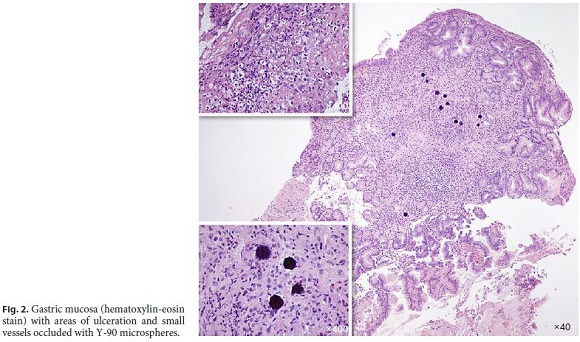Serviços Personalizados
Journal
Artigo
Indicadores
-
 Citado por SciELO
Citado por SciELO -
 Acessos
Acessos
Links relacionados
-
 Similares em
SciELO
Similares em
SciELO
Compartilhar
GE-Portuguese Journal of Gastroenterology
versão impressa ISSN 2341-4545
GE Port J Gastroenterol vol.27 no.6 Lisboa dez. 2020
https://doi.org/10.1159/000507202
IMAGES IN GASTROENTEROLOGY AND HEPATOLOGY
Yttrium-90-Induced Gastropathy: A Potential Equivocal Finding
Gastropatia induzida por yttrium-90: um potencial confundidor
Rui Castroa, Diogo Libânioa, Pedro Heitorb, Manuel Jácomeb, Rui Silvaa
aDepartment of Gastroenterology, Portuguese Oncology Institute of Porto, Porto, Portugal; bDepartment of Pathology, Portuguese Oncology Institute of Porto, Porto, Portugal
* Corresponding author.
Keywords: Colorectal cancer, Gastropathy, Selective internal radiation therapy, Yttrium-90
Palavras-Chave: Cancro colo-retal, Gastropatia, Radioterapia seletiva interna, Yttrium-90
Introduction
Selective internal radiation therapy with yttrium-90 (Y-90) spheres is used in the treatment of unresectable hepatic malignancies. With the increasing use of selective internal radiation therapy, there has been some reports of secondary associated gastric lesion such as ischemic ulceration.
Case Report
We report the case of a 44-year-old female admitted to our institute in January 2016 with the diagnosis of sigmoid colon adenocarcinoma. At the time of the diagnosis, the patient presented multiple liver metastases with dimensions between 1 and 4 cm. Despite this fact, the patient was submitted to a left colectomy in April 2016, with a chirurgical staging of pT4bN0M1. In this context, she initiated palliative chemotherapy with stabilization of liver metastatic disease. At this point, the patient was presented in a multidisciplinary group consultation and it was decided to perform selective internal radiation therapy with Y-90 spheres. The patient was submitted to two sessions of radioembolization, one in January 2018 and the other in February 2018. After the second session, the patient developed sudden onset of epigastric pain. Based on these symptoms, she performed a gastroscopy in March 2018 that revealed a pyloric circumferential ulcer with some ischemic features (Fig. 1), and biopsy samples were collected from this lesion. Histopathologic examination revealed ischemic and regenerative changes, significant inflammatory infiltrate and some vessels occluded with Y-90 microspheres (Fig. 2). After the diagnosis, the patient started therapy with proton pump inhibitors with only mild symptoms of regression. Fortunately, the pyloric ulceration did not evolve to a stricture, and the patient never experienced gastric outlet obstruction symptoms.


Discussion
Selective internal radiation therapy with Y-90 spheres is generally well tolerated, but up to 27% of the patients may experience gastrointestinal adverse events resulting from migration or misallocation of Y-90 spheres. These adverse events may include abdominal pain, nausea, vomiting, ulceration, cholecystitis, pancreatitis, and liver damage. In this study, we present a case of gastric ulceration. This type of lesions can persist for several months after initial therapy as a result of ischemia, and its management can be challenging due to the limited role of acid-suppressing medications. Gastrectomy could be considered for refractory cases. [1–3]. Due to its potential puzzling effect regarding clinical and endoscopic features, it is important for endoscopists to always consider this differential diagnosis in patients presenting with abdominal pain and previous history of radioembolization therapy. With this case, we provide a striking and clinically important message that is highlighted through images that clearly present the endoscopic features and histopathological findings, which constitutes an important learning tool. We think that these visual examples can be of great importance to remind physicians of this potential adverse event that can be easily forgotten or even a potential equivocal finding if careful analysis of the patient’s history is not performed.
References
1 Vente MA, Wondergem M, van der Tweel I, van den Bosch MA, Zonnenberg BA, Lam MG, et al. Yttrium-90 microsphere radioembolization for the treatment of liver malignancies: a structured meta-analysis. Eur Radiol. 2009 Apr;19(4):951–9.
2 Ogawa F, Mino-Kenudson M, Shimizu M, Ligato S, Lauwers GY. Gastroduodenitis associated with yttrium 90-microsphere selective internal radiation: an iatrogenic complication in need of recognition. Arch Pathol Lab Med. 2008 Nov;132(11):1734–8.
3 Kothari S, Li Y, Berkelhammer C, Almouradi T. Radiation gastritis after Yttrium-90 radioembolization. Gastrointest Endosc. 2018 Dec;88(6):965–6.
Statement of Ethics
This work is not a human trial. Data provided in this case report do not identify the patient.
Disclosure Statement
The authors have no potential conflicts of interest.
Funding Sources
The authors did not receive financial support for this study.
* Corresponding author.
Rui Castro
Department of Gastroenterology, Portuguese Oncology Institute of Porto
Rua Dr. António Bernardino de Almeida
PT–4450-590 Porto (Portugal)
Received: October 7, 2019; Accepted: December 30, 2019
Author Contributions
All authors contributed equally to this paper with the conception and design of the study, literature review and analysis, drafting, critical revision and editing, and final approval of the final version.














